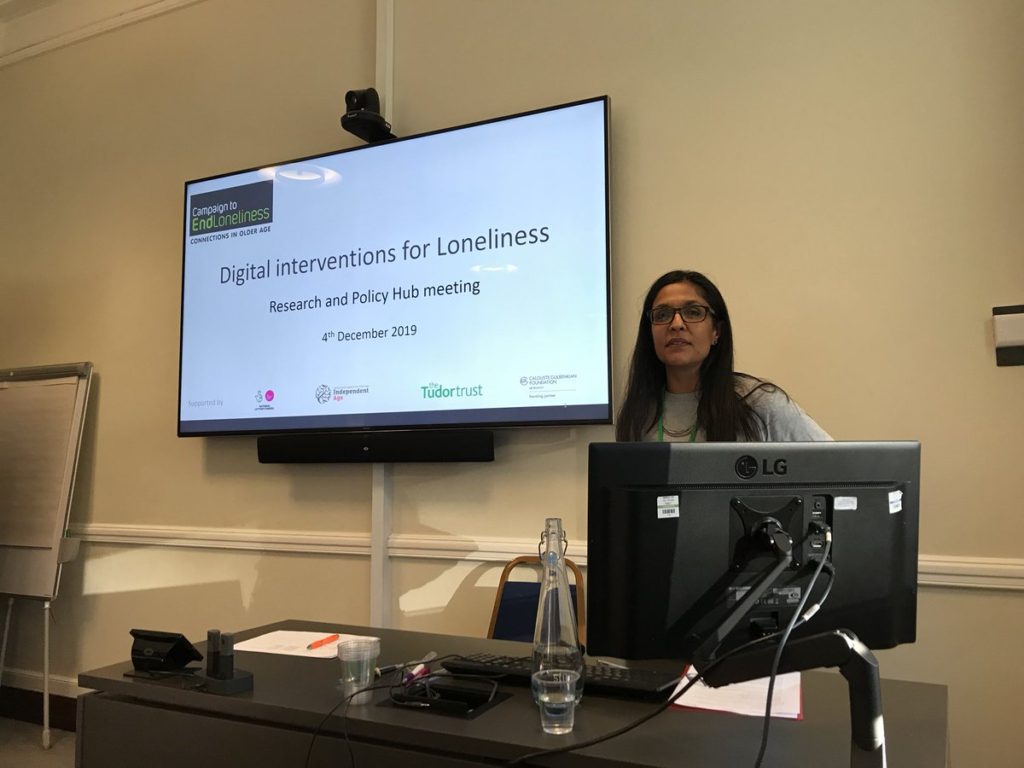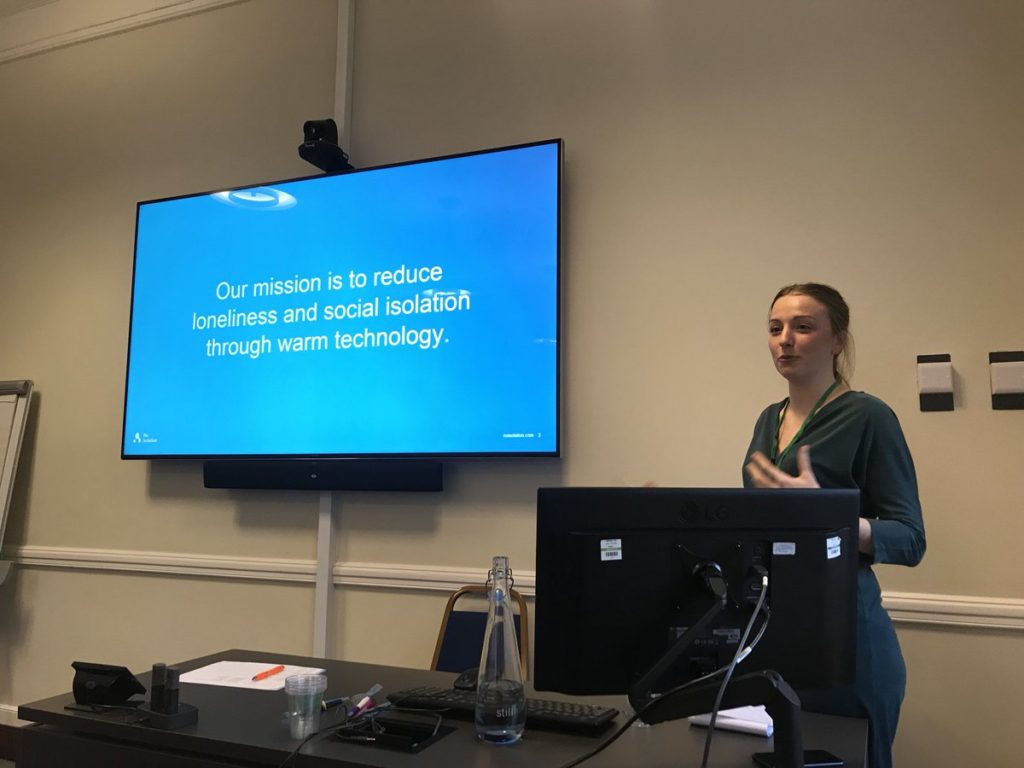On Wednesday 4 December 2019, we hosted our latest Policy and Research Hub at London’s Senate House. Here we explore the key insights.
“Is technology driving us apart? Are we alone, as it were, together?”
At our latest Research and Policy Hub we heard from leading researchers and people working in the field in the charitable and commercial sectors to find the answer.
To help us do that Kalpa Kharicha Head of Innovation, Policy and Research here at the Campaign framed the discussion: we’re looking at digital technologies for people living in the community that are focussed on tackling loneliness. Although specific adaptations for particular conditions or disabilities can help – that would make for a very long meeting.

Dr Kharicha outlined the Campaign’s belief that “technology may be a means to connect with the outside world, or of engaging in relationships with others. We’re not suggesting that technology should be a replacement for direct human interaction.”
Barriers for older people
One risk is that older people are excluded from the rapid pace of technological developments, worsening isolation. Leela Damodaran, Emeritus Professor of Digital Inclusion and Participation at Loughborough University outlined a series of barriers faced by older people to using digital technology. We cannot presume older people are not online because they are just not interested.
Sometimes the design of devices makes them impossible to use. Touch screens present challenges for people with poor circulation due to a lack warmth in their fingertips that the technology relies on. But the biggest barrier identified by older people is the absence of IT support. People in work have training, regularly updated software and access to a helpdesk at no cost to them as individuals. Older people managing their own IT have none of this. They may get a taster session at best. This lack of support can undermine people’s self-confidence meaning they believe that this is not something they are competent in.
What we need is sustainable long-term infrastructure in the community rather than short-term pilots and tasters. That means locally led collaboration with users, businesses, and the voluntary and statutory sectors.
Building connections
But if people have got online – either through computers or their phones – what would they want to help them build connections? Professor Niall Hayes of Lancaster University worked closely with the community in South Lakeland to answer this question.
Through creating an app he found that people want to know what is going on and what events and services are like. But they also need to know a whole set of other information such as bus times, whether you can get back before dark, if there are toilets along the route.
And reflecting on the issues highlighted by Professor Damodaran, many people are getting help from those around them to access this information. This kind of ‘mediated access’ from those who have friends and family to call on often worked well for people. Nevertheless, there is a real risk of digital exclusion; as more people use digital methods, long established social practices can be become disrupted. It struck me that as local newspapers have declined it has become almost impossible to know what is going on in my area without access to the internet.
Wavelength
Our next speakers reminded us how the whole range of technologies can help us connect. The Wavelength charity started in 1939 to give radios to people who were bed bound so that they had some connection to the outside world. 80 years on they still give radios as well as TVs and tablets to individuals and groups to help tackle loneliness.
Cherish Watton, communications officer of Wavelength presented findings from their collaboration with the University of York. Using the loneliness measures recommended in the English loneliness strategy they have found a statistically significant drop in people’s loneliness in people using their services.
No Isolation

We also heard from two startups who are addressing loneliness with new products. No Isolation, a Norwegian company, spent time talking to older people about how they would like to connect with their family and tried various ideas and prototypes to see what worked. They have settled on a simple device that resembles a traditional television that is switched on with the volume dial.
Family and friends of the older person can send photos and messages as well as make video calls. Harriet Gridley explained how qualitative research with users by OsloMet university has found that it has increased contact through the devices as one would expect. But it is even leading to more offline meetings as families are more in touch with each other.
Connec, a Danish company, are about creating connections outside of families by using shared interests to create connections for online befriending. Volunteers receive the training they need through the app and then go on to build relationships with lonely or isolated people. Flemming Munch said that people who came in with challenges are becoming volunteers to help others through the programme.
Slow social media
The most radical piece of research on the day was presented by Professor David Frohlich of the University of Surrey. Much social media is ‘one-to-many’ – where updates or content go to a very large group of people. This can be off-putting to many people so they have developed the idea of a very different kind of online social network. In their concept, three people are in the network and their interactions go via a mediator.
The idea was tested with a widower and his two grown-up children. They were given various prompts to send a more ‘meaningful message’ in the form of text, photo or video. Examples of prompts were to take a video of where they were or to record them singing a song. The research found that it strengthened their relationships and feelings of connection. It also suggests a very different way of doing social media – as Professor Frohlich described it – “slow social media”.
Building confidence
Beyond the individual examples some common themes emerged from the discussions. As ever in loneliness, what brings people together are shared interests such as hobbies or family relationships. Another theme is that we need to think carefully about what will build confidence in using digital technology rather than undermine it. The way in which loneliness can eat at people’s self-belief makes this especially important.
To be successful means working closely with older people to develop and refine products or services so that they actually work for people. The lessons of co-design were that products needed to be easy to use while having support available and they needed to help people pursue their interests.
The final theme of the day was that while there are pitfalls there is also huge potential for the whole range of digital technologies to contribute to combating loneliness whether by helping people connect to their communities, existing friends and family or to make new connections.





No comments on this article yet. Please feel free to submit a comment below.
By submitting a comment you grant Campaign to End Loneliness a perpetual license to reproduce your words and name/web site in attribution. Inappropriate and irrelevant comments will be removed at an admin's discretion. Your email is used for verification purposes only, it will never be shared.